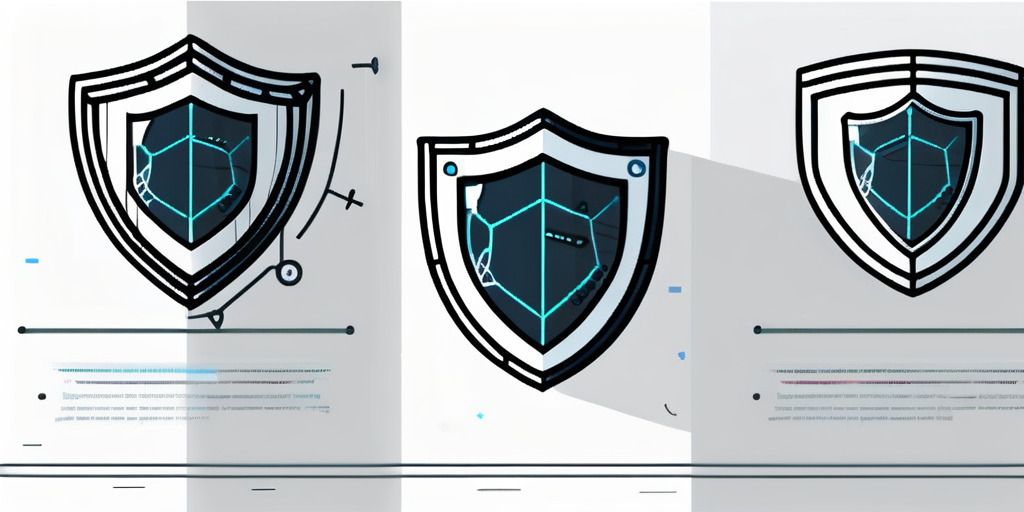Web application security testing is a critical aspect of ensuring the safety and integrity of web applications. In today’s digital landscape, where cyber threats are becoming increasingly sophisticated, it is essential for organizations to prioritize the security of their web applications. This article explores the core concepts of web app security testing, delving into its importance, defining the process, and discussing key elements and different types of web app security testing.
Understanding Web App Security Testing
Before diving into the intricacies of web app security testing, it is crucial to grasp why it is vital in web applications. The growing dependence on web applications to carry out various tasks and expand the attack surface makes security testing indispensable. Web app security testing identifies vulnerabilities and weaknesses that malicious actors could exploit, allowing organizations to rectify them before damage occurs.

The Importance of Security Testing in Web Applications
With increasing data breaches and cyber attacks, the significance of web app security testing cannot be overstated. Failure to conduct thorough security testing can leave web applications vulnerable to a wide range of threats, including but not limited to data leaks, injection attacks, cross-site scripting (XSS), and session hijacking. By investing in security testing, organizations can proactively address potential vulnerabilities, safeguard sensitive data, and protect their reputation.
Defining Web App Security Testing
Web app security testing involves the evaluation of a web application’s security posture through various methodologies. It encompasses a range of activities, including analyzing the application’s architecture, assessing its code, and simulating attacks to identify potential weaknesses. The goal is to ensure that web applications can withstand cyber attacks and maintain data confidentiality, integrity, and availability.
One of the key aspects of web app security testing is analyzing the application’s architecture. This involves examining the components and layers of the web application, such as the front-end user interface, the back-end server, and the database. By understanding how these components interact and communicate with each other, security testers can identify potential vulnerabilities that may arise from misconfigurations or weak integration points.
In addition to analyzing the architecture, security testers also assess the code of the web application. This involves reviewing the source code to identify any coding errors or vulnerabilities attackers could exploit. Common coding vulnerabilities include SQL injection, cross-site scripting (XSS), and insecure direct object references. Security testers can help developers identify and fix these vulnerabilities by conducting a thorough code review before the application is deployed.
Simulating attacks is another crucial aspect of web app security testing. Using various tools and techniques, security testers attempt to exploit vulnerabilities in the web application, just as a real attacker would. This can include attempting to gain unauthorized access to sensitive data, manipulating input fields to execute malicious code, or attempting to bypass authentication mechanisms. By simulating these attacks, security testers can identify potential weaknesses and provide recommendations for improving the application’s security posture.
Overall, web app security testing plays a critical role in ensuring the security and integrity of web applications. By identifying vulnerabilities and weaknesses before they can be exploited, organizations can protect their sensitive data, maintain customer trust, and avoid the financial and reputational damage that can result from a successful cyber attack. It is an ongoing process that should be integrated into the development lifecycle of web applications to ensure continuous security improvement.
Key Elements of Web App Security Testing
When it comes to web app security testing, several key elements play a crucial role in ensuring comprehensive coverage. These elements focus on different aspects of a web application’s security and collectively contribute to mitigating vulnerabilities. Let’s dive deeper into some of the essential elements:

Authentication and Authorization Testing
Authentication and authorization systems are integral to web application security. Thorough testing in this area helps organizations identify weaknesses in the verification process, such as weak passwords, improper session handling, or inadequate access controls. By conducting comprehensive authentication and authorization testing, organizations can prevent unauthorized access and strengthen the overall security of the web application.
During authentication testing, security experts simulate various scenarios to evaluate the effectiveness of the login mechanism. They may attempt to bypass authentication controls, test for weak password policies, or assess the resilience of multi-factor authentication methods. This rigorous testing ensures that only legitimate users can access the application and its sensitive data.
Authorization testing, on the other hand, focuses on examining the application’s access controls. Testers analyze whether users are granted appropriate privileges and permissions based on their roles and responsibilities. By identifying and rectifying any authorization flaws, organizations can prevent unauthorized users from gaining access to sensitive areas of the application.
Session Management Testing
Session management testing assesses a web application’s ability to create, manage, and terminate user sessions securely. During this testing phase, security experts meticulously examine session cookies, expiry mechanisms, and session regeneration techniques to ensure that sessions remain secure throughout a user’s interaction with the application.
One common vulnerability that session management testing aims to address is session hijacking. By attempting to hijack a session, testers can identify weaknesses in the session handling process and recommend appropriate countermeasures. Additionally, this testing helps organizations prevent unauthorized access to sensitive information by ensuring that session tokens are properly encrypted and protected.
Data Validation Testing
Data validation testing is a critical element of web app security testing that focuses on scrutinizing how a web application processes user input. By testing for vulnerabilities such as cross-site scripting (XSS) and SQL injection attacks, organizations can fortify the application’s defenses against malicious input.
Security experts thoroughly examine the application’s input fields, forms, and data submission mechanisms during data validation testing. They intentionally inject malicious code or malformed data to assess the application’s ability to detect and reject such inputs. By implementing robust data validation measures, organizations can prevent data manipulation and compromises to the application’s integrity.
In addition to XSS and SQL injection attacks, data validation testing encompasses input-related vulnerabilities, such as command injection, XML external entity (XXE) attacks, and remote file inclusion. Organizations can ensure that user input is processed safely and securely by addressing these vulnerabilities.
By focusing on these key elements of web app security testing, organizations can strengthen the overall security posture of their web applications. It is essential to conduct regular and comprehensive testing to identify and address vulnerabilities before malicious actors can exploit them.
Different Types of Web App Security Testing
Web app security testing encompasses various methodologies, each with its own unique approach and benefits. Here are three commonly used types:

Static Application Security Testing (SAST)
SAST involves scanning the source code or compiled application to identify potential vulnerabilities. By examining the codebase, developers and security professionals can uncover potential flaws and misconfigurations early in the development lifecycle, allowing for prompt remediation.
During a SAST, a thorough analysis of the code is performed. This includes checking for common coding mistakes, such as buffer overflows, SQL injection, and cross-site scripting (XSS) vulnerabilities. Additionally, SAST tools can detect insecure coding practices, such as using deprecated functions or weak cryptographic algorithms.
By identifying these vulnerabilities early on, developers can address them before the application is deployed, reducing the risk of exploitation and ensuring a more secure web application.
Dynamic Application Security Testing (DAST)
DAST involves testing a web application in a runtime environment to identify vulnerabilities. By mimicking real-life attack scenarios, DAST provides insights into how an application reacts to different inputs and attempts to exploit any weaknesses. This testing approach uncovers vulnerabilities that may only manifest in a dynamic environment.
During a DAST, the web application is subjected to various automated attacks, such as SQL injection, cross-site scripting, and parameter manipulation. The goal is to identify vulnerabilities an attacker can exploit in a real-world scenario.
One of the advantages of DAST is that it can identify vulnerabilities that may have been missed during the development phase. It also provides a more realistic assessment of the application’s security posture, as it considers the application’s behavior in a live environment.
Interactive Application Security Testing (IAST)
IAST combines elements of both SAST and DAST. It involves embedding security testing components into the application and monitoring its behavior during runtime. This real-time and continuous testing approach provides comprehensive coverage by detecting vulnerabilities at the code level and during application execution.
During an IAST, the application is instrumented with security sensors that monitor its execution. These sensors capture data about the application’s behavior, such as inputs, outputs, and interactions with external systems. This data is then analyzed to identify potential vulnerabilities.
One of the key advantages of IAST is its ability to provide accurate and actionable results. Since it operates within the application’s runtime environment, it can detect vulnerabilities specific to its configuration and dependencies. This makes IAST particularly effective in identifying vulnerabilities arising from interaction between different application components.
Furthermore, IAST provides real-time feedback to developers, allowing them to address vulnerabilities as they are discovered. This significantly reduces the time and effort required for remediation, resulting in a more secure web application.
The Process of Web App Security Testing
Executing a successful web app security testing process involves meticulous planning, thorough execution of tests, and careful analysis and reporting. Let’s explore each step in detail:
Planning and Preparation
The planning phase involves defining the scope of the testing, identifying potential risks and vulnerabilities, and establishing a test strategy. It is essential to gather all necessary resources, such as testing tools and environments, and establish clear communication channels and timelines for the process.
During the planning phase, conducting a comprehensive risk assessment is crucial to identify potential threats and vulnerabilities that the web application may face. This includes analyzing the application’s architecture, identifying potential entry points for attackers, and understanding the sensitive data that needs protection. Organizations can prioritize their testing efforts and allocate resources effectively by conducting a thorough risk assessment.
Furthermore, in the planning phase, it is essential to define the objectives of the security testing process. This includes determining the specific goals and expectations, such as identifying vulnerabilities, validating security controls, or ensuring compliance with industry standards and regulations. Organizations can clearly define the objectives by aligning their testing activities with their security strategy.
Execution of Tests
During the execution phase, the planned tests are carried out using the chosen methodologies, such as SAST (Static Application Security Testing), DAST (Dynamic Application Security Testing), or IAST (Interactive Application Security Testing). This phase simulates attacks, tests individual application components, and assesses overall system resilience.
One of the key aspects of the execution phase is the selection of appropriate testing tools and techniques. Different tools offer various capabilities, such as code analysis, vulnerability scanning, or penetration testing. Organizations must choose tools that align with their specific requirements and provide accurate and reliable results.
Moreover, during the execution phase, it is crucial to simulate real-world attack scenarios to identify vulnerabilities malicious actors could exploit. This includes testing for common web application vulnerabilities, such as SQL injection, cross-site scripting (XSS), or insecure direct object references. By emulating real-world attacks, organizations can assess the effectiveness of their security controls and identify potential weaknesses.
Analysis and Reporting
Once the tests are completed, the findings must be analyzed and documented. This phase involves assessing the vulnerabilities and their potential impact, prioritizing them based on risk levels, and developing a comprehensive report.
During the analysis phase, evaluating the severity and potential consequences of each identified vulnerability is essential. This includes considering the likelihood of exploitation, the impact on the confidentiality, integrity, and availability of data, and the potential financial or reputational damage that could result from an attack. Organizations can prioritize their remediation efforts and allocate resources effectively by assessing the vulnerabilities’ impact.
The analysis phase also provides clear and actionable recommendations for addressing the detected vulnerabilities. These recommendations should include specific steps to mitigate the risks, such as applying patches, configuring security settings, or implementing additional security controls. By providing actionable recommendations, organizations can facilitate prompt remediation and improve the overall security posture of the web application.
In conclusion, web app security testing plays a crucial role in safeguarding web applications from evolving cyber threats. Organizations can proactively identify and address potential vulnerabilities by understanding the core concepts, key elements, and various types of web app security testing. The process involves careful planning, execution of tests, and thorough analysis, ensuring comprehensive evaluation and robust security measures. Prioritizing web app security testing is essential for maintaining the integrity and safety of web applications in today’s digital landscape.
As you’ve learned, web app security testing is not just necessary; it’s a strategic move to protect your organization’s digital assets and reputation. Blue Goat Cyber, a Veteran-Owned business, is at the forefront of providing specialized B2B cybersecurity services. Whether you’re in the healthcare industry needing medical device cybersecurity, seeking to ensure HIPAA and FDA compliance, or aiming for SOC 2 and PCI penetration testing, our expertise is tailored to secure your operations against cyber threats. Contact us today for cybersecurity help, and let us help you maintain the integrity and safety of your web applications.
Contact us for Web Application Testing. We offer SAST, DAST, and Web App Pen Testing.


